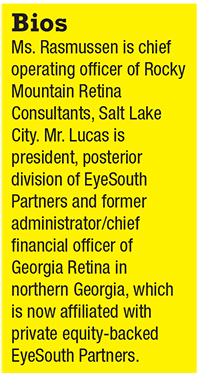The private equity incursion in ophthalmology appears alive and well in 2019. Ophthalmology is a fragmented market, and the retina subspecialty in particular even more so. Given the ample number of practice groups, there’s no reason to believe this phenomenon will be subsiding anytime soon.
Here’s a close look at private equity in ophthalmology, and why some groups opt to maintain their independence while others jump in.
Why practices consider PE
The reasons to consider private equity are consistent across the country. They are:
-
“De-risking” the physicians by removing them personally from the ever-changing Medicare and regulatory environments.
-
Gaining capital to fund new and expanded clinic locations and patient-preferred surgical centers.
-
Getting relief from the administrative pressures of operating an independent practice.
-
Seeking an alternative to hospital affiliation and retaining some autonomy. Geography may play a role in a practice’s approach to private equity. Those in rural settings and regions with limited competition may want to stay the course. Practices in more urban markets with a lot of competition, particularly smaller to mid-size groups that may not be able recruit sophisticated administrative support or get the capital to grow and upgrade equipment, may find themselves attracted to the expertise and capital private equity can bring. Every market has its local nuances, and every retina group its unique circumstances.
 |
Why PE likes health care
Who are these private-equity firms and why are they here? Private equity—non-publicly traded investment firms—have been around for decades. Industries that are widely diverse, profitable and oftentimes undergoing radical change and increased regulation have long attracted attention for opportunities to consolidate. Just look at energy, telecommunications and banking, to name a few.
Health care, and private medical practices in particular, pose some unique challenges, primarily that health care is local and specialty-specific. What plays in Peoria doesn’t always apply in Albuquerque.
One factor that always prevails, however, is quality patient care. Patients demand it, and equity firms are attracted to it. Here, the physicians remain in full clinical control. Equity groups knowledgeable about health care encourage the development of clinical standards and organized physician advisory boards to direct the clinical initiatives within their management model.
The culture of potential partners
Whether you are considering a direct investment from a private equity firm or an affiliation with a private-equity backed management company, spend time understanding the culture and philosophies of these potential partners. Strategies, expertise and personalities among private-equity partners can be as diverse as practices.
These PE-backed models, when structured properly, have little if any impact on the daily lives of retina specialists and clinic functions. Equity firms know what they know, and perhaps more importantly from the affiliating doctor’s perspective, know what they don’t know. They leave clinical matters to the specialists.
The most common structure of private equity ownership is the management services organization (MSO). The MSO generally assumes administrative functions—payroll, accounts payable and general accounting/tax preparation. Most typically offer other critical business functions, such as strategic planning, revenue cycle management, human resources/benefits management, compliance and information technology.
Bringing formality to financials
Partnering with the right private-equity firm will enable your current administrative team to have a starring role in both the integration process as well as operational and financial reporting post-affiliation. It will bring formality to reporting and financial monitoring.
Most retina groups utilize cash-basis accounting because it offers a reasonable assessment of a group’s fiscal health and eases the partners’ annual tax filing burdens. Most retina groups also utilize various metrics and benchmarking data to assist in managing the business. Groups considering affiliation should expect a more corporate and frequent approach to financial reporting and key performance indicator (KPI) tracking. Accrual-based accounting, annual operating and capital budgets, and regular communication of KPIs will be the norm.
Depending on a group’s level of internal accounting sophistication and its management reporting tools within existing systems, this process brings a potentially significant deviation from the small-business management mentality of most medical practices. But this advanced process also allows for better financial understanding, more accurate projections, identification of critical trends, adjustments of operational processes and development of detailed growth plans—exactly what every practice wishes it had and right in the wheelhouse of private equity.
What path is right for you?
By now, many retina practices have already been solicited by private-equity firms. Some have elected to stay the course. Some have chosen to affiliate with a larger entity, maintaining medical independence but foregoing some business management autonomy.
Which path is right for you? Your present circumstances—competition, referral practice decisions with private equity, the level of sophistication within your group to keep up with and adhere to added regulation and business demands, MIPS (merit-based incentive payment system), fee schedule changes, contract negotiation, recruitment, etc.—may well hold the answers. RS



